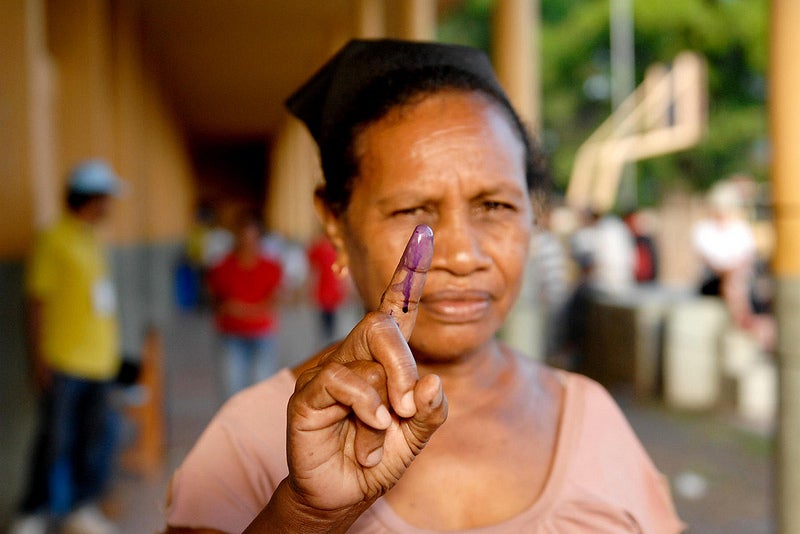
In late 2011, as part of our Institutions Taking Root (ITR) series, my colleagues and I visited some of the most remote villages in Timor-Leste to seek feedback from citizens on the performance of the Ministry of Health (MoH) and the Ministry of Social Solidarity (MSS).
The responses of citizens we met on the trip – many of whom were living on less than $1.25 per day and scarcely had any interaction with government – were intriguing.
One focus group of village chiefs in Oecusse told us that ‘despite all the problems and obstacles, the community trusts the MSS system... they deliver a service, and look after communities’. Citizens were equally magnanimous about the performance of the MoH, despite that some clinics were not functioning and the stock of medical supplies was low and irregular.
Positive perceptions of the MoH were clearly accentuated by the fact that services are free and people do not have to travel far to receive care for minor illnesses. Yet, it still left us wondering, what had the MoH and MSS done to gain the confidence of citizens? How had they built trust?
Institutions need to reconnect with local communities and set short-term, realistic goals
In Fragile and Conflict-Affected States (FCS), building ‘successful’ institutions is a tough proposition. Received wisdom holds that a shared sense of vision, a problem-solving approach in management, high specificity and low transaction tasks, and clearly defined performance standards are important for institutional development.
But what rings true in the ITR case studies is the idea that politics and society shape an institution’s development; and that the ability of an institution to navigate social and political dynamics, in a way that enhances its internal management and builds trust, are key to its success.
MoH and MSS did this in both similar and distinct ways. Their interactions with their respective political patrons differed: the MSS was buoyed by political authority as a result of social unrest; while the MoH had brokered a deal with the then Prime Minister to insulate the ministry from political interference.
Yet, both institutions had a human presence at the district and village levels, including during periods of social instability.
They recruited staff from the host communities in which they worked; and they actively engaged with traditional authorities and expectant citizens – including rebels, demonstrators and the internally displaced – not just to hear their demands, but also to understand and align with locally accepted ways of doing things.
The MSS adopted local conflict resolution practices, first to reintegrate the internally displaced, and then to resolve social conflicts, which signalled to communities that the ministry was working in their interests. As one community respondent put it, ‘the [Ministry’s] work is to establish the peace, to come and talk about the problems in our community, the unresolved problems’.
In health, the rapid construction of community and mobile clinics and a partnership with donors, local clinicians and NGOs to support the continuity of health services in the villages, in the violent aftermath of the country’s referendum, would ensure that the MoH was built from the ground up.
Health administrators focused on short-term goals by giving priority to the delivery of basic health services and the implementation of three-month district health plans, instead of attempting to reach beyond their means to deliver a multi-year heath strategy.
According to a World Bank report, by 2006, wherever one would travel in Timor-Leste to ask which public service had become most effective, the answer was unanimously health.
What’s in it for development practitioners?
The experience of the MoH and MSS suggest that institutional development is often highly idiosyncratic and can be subject to reversals; and gaining trust, particularly for service delivery, requires adept navigation of social and political expectations as well as the ability to reflect local ways of doing things. But where does this leave development practitioners? How do we programme for these results or pathways?
From the outside looking in, it can be difficult for development practitioners to understand how social and political dynamics work. Yet, the experiences of MoH and MSS suggest that accounting for local conditions – such as elite interests and influence, citizen expectations and local sources of authority and decision-making – can go a long way towards better programming for results and towards building more capable institutions.
To do this, conventional tools such as sharing public information or organizing consultations to address citizens’ grievances can begin to build bridges and contributes to rebuilding confidence.
But in the end, the most productive institutional spaces in which to invest are those in which, political and administrative elites and their constituents are actively negotiating the new rules of the game; and here, the role of development practitioners is not to strive for broad-based systems change, but to work with our partners in incremental and innovative ways to nudge these negotiations toward positive institutional and developmental outcomes.


Join the Conversation